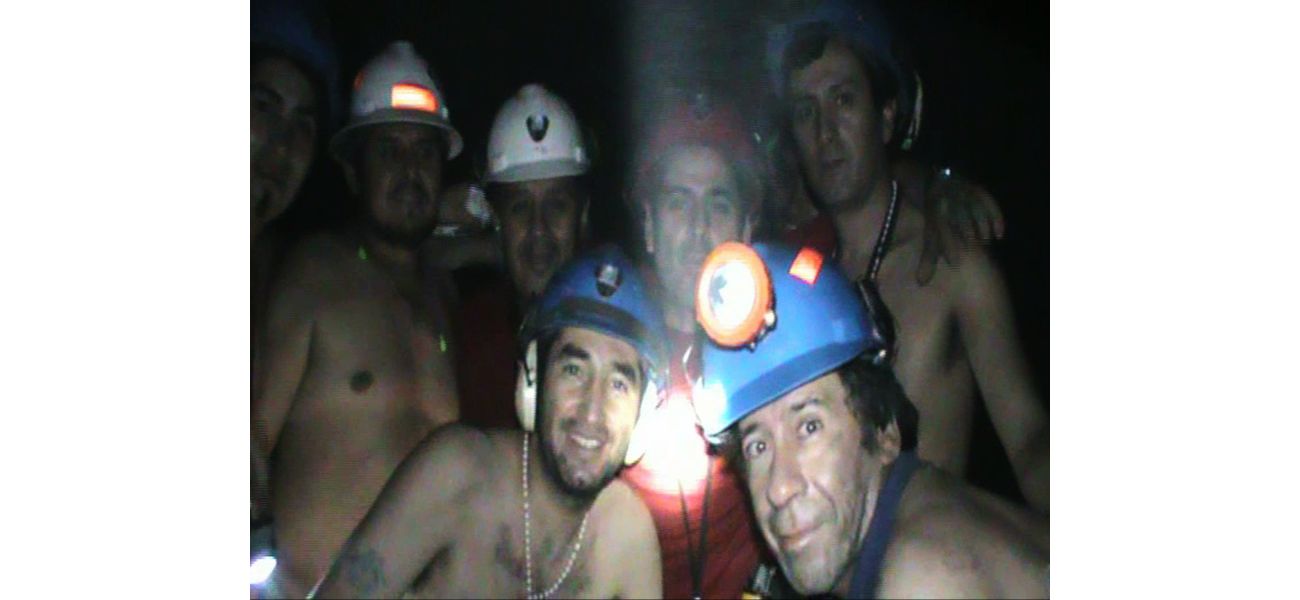The Chilean miners brought the world together and caused division among themselves.
Everyone is on the same level, with no distinction between bosses and employees.
October 13th 2024.

The world stood still as the news of the trapped Chilean miners spread like wildfire. It was a dire situation, with 33 men trapped 2,300 feet underground in a collapsed mine. The whole world held their breath as they watched the events unfold, with over a billion people tuning in to witness one of the most extraordinary rescues in modern history.
These miners, known as ‘Los 33,’ quickly became symbols of resilience and the triumph of the human spirit. After spending 69 days buried alive in the San José Mine in the Atacama Desert, they emerged as unlikely heroes. Their incredible story even caught the attention of Hollywood, with a major film starring Antonio Banderas being made about their ordeal.
But as time passed, the once unbreakable bonds between the miners began to crack. The fame and attention brought upon them had its consequences, and the men found themselves struggling with trauma, illness, jealousy, and bitterness. This is the story of the Copiapó miners and what happened to them after their harrowing rescue.
The disaster began on a seemingly normal day on August 5, 2010, at the San José Mine in Copiapó. The miners were hard at work, unaware of the danger lurking just beneath their feet. Suddenly, they felt intense vibrations and before they knew it, a massive explosion shook the mine, collapsing the passageways and filling the air with dust and debris.
As the dust settled, the miners found themselves trapped inside with no way out. The source of the explosion was a giant block of stone that had broken off from the mountain above and caused the entire mine to collapse. Panic set in as the men realized the severity of their situation. Luis Urzúa, the shift leader, likened the sight of the massive stone to the one placed over Jesus' tomb.
For over two weeks, the miners had no contact with the outside world. They survived on minimal rations, with only two spoonfuls of tuna, half a cup of milk, a biscuit, and water shared every 48 hours. It was a terrifying and uncertain time, but the men refused to give up. Under Urzúa's leadership, they organized themselves and created a makeshift tent city called 'Camp Hope.' They maintained discipline and structure in the dark and claustrophobic environment, with humor being their saving grace.
Despite the immense psychological toll of being trapped underground for so long, the miners remained united. They sang, daydreamed, and made democratic decisions together. As Urzúa famously said, "We are all equal now...There are no bosses and employees." Their resilience and strength in the face of such adversity became a source of inspiration for people all over the world.
Meanwhile, above ground, a massive rescue operation was underway. It took 17 days for the rescue team to confirm that the miners were still alive, but when a drillbit bored into the cavern where the men were taking refuge, it resurfaced with a note attached in red ink: "Estamos bien en el refugio, los 33." This message ignited celebrations in Chile and around the world, as it was a miraculous confirmation that all 33 miners were alive.
The Chilean government, led by President Sebastián Piñera, spared no expense in bringing the miners back to the surface. International experts and engineers joined forces with Chile's own mining and rescue teams to devise a plan to extract the men. It was a risky operation, with concerns about further cave-ins and the miners' physical and mental health after such a long ordeal.
But on October 13, 69 days after the initial collapse, the final phase of the rescue began. The whole world watched in awe and anticipation as the first miner, Florencio Ávalos, emerged from the capsule just after midnight. It was a moment of triumph and relief, as the men were finally reunited with their families and the outside world.
The story of the Copiapó miners will forever be etched in our memories as a testament to the human spirit. From the initial disaster to their incredible rescue, their story captured the hearts of people all over the world. And although the fame and attention may have brought some challenges, the miners will always be remembered as symbols of resilience and the triumph of the human spirit.
In 2010, the world was captivated by the harrowing tale of 33 Chilean miners trapped 2,300 feet underground in a collapsed copper-gold mine. For 69 days, these men were buried alive in the dark, desolate depths of the San José Mine in the Atacama Desert. It was a disaster that shook the nation and captured the hearts of people around the globe.
The miners, known as 'Los 33', were suddenly thrust into the spotlight as they became symbols of resilience and the triumph of the human spirit. Their story was one of unbreakable bonds and unwavering determination in the face of unimaginable adversity. And when they were finally rescued, they were hailed as heroes and even became the stars of a Hollywood film.
But as the years went by, the men who had once been united by their remarkable survival story found themselves facing new challenges. Trauma, illness, jealousy, and bitterness began to take hold, and their once unbreakable bonds were put to the test. This is the story of the Copiapó miners and what happened to them after their miraculous rescue.
It all began on August 5, 2010, during a typical day shift at the notoriously dangerous San José Mine. As the miners were working deep inside the mountain, they suddenly felt intense vibrations. And then, with a deafening roar, the mine collapsed, engulfing them in a cloud of gritty stone dust.
When the dust settled, the miners were faced with a terrifying reality. A giant block of stone, weighing 770,000 tonnes and as tall as a forty-five story building, had broken off and crashed through the mine, destroying everything in its path. As they surveyed the damage, the miners couldn't help but feel a sense of panic and despair. But they refused to give up.
Under the leadership of shift leader Luis Urzúa, the men organized themselves and created a makeshift tent city they called 'Camp Hope'. Urzúa's words, "We are all equal now...There are no bosses and employees," set the tone for their survival. They maintained discipline, structure, and even found moments of laughter and joy amidst the darkness and uncertainty.
Meanwhile, above ground, a massive rescue operation was underway. It took 17 days for the rescue team to even confirm that the miners were still alive. But when a drill finally reached the cavern where the men were taking refuge, it brought back a note written in red ink: 'Estamos bien en el refugio, los 33' (We are well in the shelter, the 33). The world rejoiced at this miraculous confirmation that all 33 miners were alive.
With the support of the Chilean government, led by President Sebastián Piñera, and the help of international experts and engineers, a plan was devised to bring the miners back to the surface. It was a risky operation, with concerns about further cave-ins and the miners' physical and mental well-being.
But despite the challenges, on October 13, 69 days after the initial collapse, the final phase of the rescue began. The world watched in awe and anticipation as the first miner, Florencio Ávalos, emerged from the capsule that had been lowered into the mine. It was an emotional and historic moment as one by one, the 33 miners were safely brought back to the surface.
The Chilean miners had become global symbols of resilience and the triumph of the human spirit. But their story didn't end with their rescue. The years that followed would test their strength and resilience in new ways, and their bond as 'Los 33' would be put to the ultimate test. But their incredible story of survival and hope will never be forgotten.
These miners, known as ‘Los 33,’ quickly became symbols of resilience and the triumph of the human spirit. After spending 69 days buried alive in the San José Mine in the Atacama Desert, they emerged as unlikely heroes. Their incredible story even caught the attention of Hollywood, with a major film starring Antonio Banderas being made about their ordeal.
But as time passed, the once unbreakable bonds between the miners began to crack. The fame and attention brought upon them had its consequences, and the men found themselves struggling with trauma, illness, jealousy, and bitterness. This is the story of the Copiapó miners and what happened to them after their harrowing rescue.
The disaster began on a seemingly normal day on August 5, 2010, at the San José Mine in Copiapó. The miners were hard at work, unaware of the danger lurking just beneath their feet. Suddenly, they felt intense vibrations and before they knew it, a massive explosion shook the mine, collapsing the passageways and filling the air with dust and debris.
As the dust settled, the miners found themselves trapped inside with no way out. The source of the explosion was a giant block of stone that had broken off from the mountain above and caused the entire mine to collapse. Panic set in as the men realized the severity of their situation. Luis Urzúa, the shift leader, likened the sight of the massive stone to the one placed over Jesus' tomb.
For over two weeks, the miners had no contact with the outside world. They survived on minimal rations, with only two spoonfuls of tuna, half a cup of milk, a biscuit, and water shared every 48 hours. It was a terrifying and uncertain time, but the men refused to give up. Under Urzúa's leadership, they organized themselves and created a makeshift tent city called 'Camp Hope.' They maintained discipline and structure in the dark and claustrophobic environment, with humor being their saving grace.
Despite the immense psychological toll of being trapped underground for so long, the miners remained united. They sang, daydreamed, and made democratic decisions together. As Urzúa famously said, "We are all equal now...There are no bosses and employees." Their resilience and strength in the face of such adversity became a source of inspiration for people all over the world.
Meanwhile, above ground, a massive rescue operation was underway. It took 17 days for the rescue team to confirm that the miners were still alive, but when a drillbit bored into the cavern where the men were taking refuge, it resurfaced with a note attached in red ink: "Estamos bien en el refugio, los 33." This message ignited celebrations in Chile and around the world, as it was a miraculous confirmation that all 33 miners were alive.
The Chilean government, led by President Sebastián Piñera, spared no expense in bringing the miners back to the surface. International experts and engineers joined forces with Chile's own mining and rescue teams to devise a plan to extract the men. It was a risky operation, with concerns about further cave-ins and the miners' physical and mental health after such a long ordeal.
But on October 13, 69 days after the initial collapse, the final phase of the rescue began. The whole world watched in awe and anticipation as the first miner, Florencio Ávalos, emerged from the capsule just after midnight. It was a moment of triumph and relief, as the men were finally reunited with their families and the outside world.
The story of the Copiapó miners will forever be etched in our memories as a testament to the human spirit. From the initial disaster to their incredible rescue, their story captured the hearts of people all over the world. And although the fame and attention may have brought some challenges, the miners will always be remembered as symbols of resilience and the triumph of the human spirit.
In 2010, the world was captivated by the harrowing tale of 33 Chilean miners trapped 2,300 feet underground in a collapsed copper-gold mine. For 69 days, these men were buried alive in the dark, desolate depths of the San José Mine in the Atacama Desert. It was a disaster that shook the nation and captured the hearts of people around the globe.
The miners, known as 'Los 33', were suddenly thrust into the spotlight as they became symbols of resilience and the triumph of the human spirit. Their story was one of unbreakable bonds and unwavering determination in the face of unimaginable adversity. And when they were finally rescued, they were hailed as heroes and even became the stars of a Hollywood film.
But as the years went by, the men who had once been united by their remarkable survival story found themselves facing new challenges. Trauma, illness, jealousy, and bitterness began to take hold, and their once unbreakable bonds were put to the test. This is the story of the Copiapó miners and what happened to them after their miraculous rescue.
It all began on August 5, 2010, during a typical day shift at the notoriously dangerous San José Mine. As the miners were working deep inside the mountain, they suddenly felt intense vibrations. And then, with a deafening roar, the mine collapsed, engulfing them in a cloud of gritty stone dust.
When the dust settled, the miners were faced with a terrifying reality. A giant block of stone, weighing 770,000 tonnes and as tall as a forty-five story building, had broken off and crashed through the mine, destroying everything in its path. As they surveyed the damage, the miners couldn't help but feel a sense of panic and despair. But they refused to give up.
Under the leadership of shift leader Luis Urzúa, the men organized themselves and created a makeshift tent city they called 'Camp Hope'. Urzúa's words, "We are all equal now...There are no bosses and employees," set the tone for their survival. They maintained discipline, structure, and even found moments of laughter and joy amidst the darkness and uncertainty.
Meanwhile, above ground, a massive rescue operation was underway. It took 17 days for the rescue team to even confirm that the miners were still alive. But when a drill finally reached the cavern where the men were taking refuge, it brought back a note written in red ink: 'Estamos bien en el refugio, los 33' (We are well in the shelter, the 33). The world rejoiced at this miraculous confirmation that all 33 miners were alive.
With the support of the Chilean government, led by President Sebastián Piñera, and the help of international experts and engineers, a plan was devised to bring the miners back to the surface. It was a risky operation, with concerns about further cave-ins and the miners' physical and mental well-being.
But despite the challenges, on October 13, 69 days after the initial collapse, the final phase of the rescue began. The world watched in awe and anticipation as the first miner, Florencio Ávalos, emerged from the capsule that had been lowered into the mine. It was an emotional and historic moment as one by one, the 33 miners were safely brought back to the surface.
The Chilean miners had become global symbols of resilience and the triumph of the human spirit. But their story didn't end with their rescue. The years that followed would test their strength and resilience in new ways, and their bond as 'Los 33' would be put to the ultimate test. But their incredible story of survival and hope will never be forgotten.
[This article has been trending online recently and has been generated with AI. Your feed is customized.]
[Generative AI is experimental.]
0
0
Submit Comment





